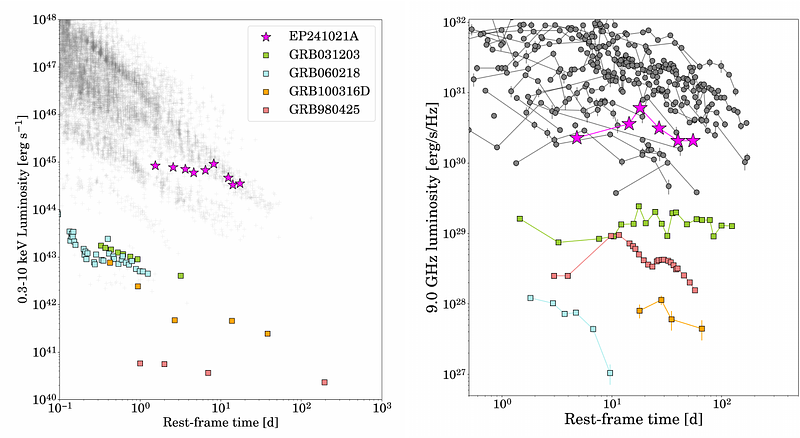The soft X-ray transient EP241021a: a cosmic explosion with a complex off-axis jet and cocoon from a massive progenitor

The soft X-ray transient EP241021a: a cosmic explosion with a complex off-axis jet and cocoon from a massive progenitor
Giulia Gianfagna, Luigi Piro, Gabriele Bruni, Aishwarya Linesh Thakur, Hendrik Van Eerten, Alberto Castro-Tirado, Yong Chen, Ye-hao Cheng, Han He, Shumei Jia, Zhixing Ling, Elisabetta Maiorano, Rosita Paladino, Roberta Tripodi, Andrea Rossi, Shuaikang Yang, Jianghui Yuan, Weimin Yuan, Chen Zhang
AbstractX-Ray Flashes (XRFs) are fast X-ray transients discovered by the BeppoSAX satellite, showing an isotropic sky distribution and a prompt emission duration between 10-1000 seconds. The observed prompt X-ray spectrum is similar to Gamma Ray Bursts (GRBs), but with a softer peak energy of the spectrum. Several pieces of evidence indicate that XRFs are connected to GRBs and likely represent their softer analogues, but their origin is still unclear. Several models have been proposed to explain the observed properties of XRF, mostly in the context of collapsar scenario, similar to GRBs but with different geometrical or physical conditions of the progenitor. These include off-axis GRBs and baryon-loaded explosions, that either produce a low Lorentz factor jet or a spherical mildly (or non-) relativistic ejecta, known as cocoons. In this paper, we present multi-wavelength observations of the afterglow of EP241021a, a soft X-ray transient detected by EP, consistent with being an XRF. We present the results of our multiwavelength campaign from radio (uGMRT, ATCA, e-MERLIN, ALMA), optical (LBT, GTC, CAHA) and X-rays (EP-FXT). EP241021a afterglow is characterized by multiple components. They represent the imprints of the interaction of a jet with the complex environment of the pre-existing progenitor, that is likely shaping its structure from a highly relativistic narrow cone to much broader and mildly relativistic cocoon components.